|
Michael McFadyen's Scuba Diving - Flinders Pier
I live in Sydney and as such, it is very easy to dive. It is only 15 minutes from my house to numerous dive sites, all of them very good. This is the same for many divers in Sydney, it is no more than 30 minutes to a dive site for a lot of Sydney divers and no more than 60 minutes for even divers living the furtherest from the coast. Melbourne is very different. Apart from a couple of pier dives inside Port Phillip Bay, it is quite a long drive from the centre of the City to decent dive sites.
Melbourne is located on the northern most part of Port Phillip Bay, a huge bay that is at least 56 kilometres long north to south and over 40 kilometres from north-west to south-east (about 80 km east to west). The entrance to the bay from Bass Strait (one of the roughest stretches of water anywhere in the world), is only 3.4 kilometres wide. Most boat diving, if not all, is done from Portsea on the eastern side of the entrance and Queenscliffe on the western side.
Another place to dive from Melbourne is at Flinders Pier which is in Westernport Bay. This is located to the east of Portsea. Mornington Peninsula is the stretch of land that fronts the south-eastern edge of Port Phillip Bay. This is located between Westernport Bay and Port Phillip Bay and is about 15 kilometres wide for most of its length. Flinders Pier is located at Flinders and is about 105 kilometres from the centre of Melbourne. It takes about two hours to drive there during the week, perhaps 90 minutes early on a weekend.
The pier consists of an older wooden pier and a newer concrete one adjacent to it, although the newer bit only goes about half the way. The pier is about 350 metres long, although the first 100 metres is either out of the water or at high tide, very shallow. In any case, it is shallow all the time as you will see. The dive site is protected to an extent by West Head from southerly and south-westerly swells, although I am sure that bigger swells will impact the site.
Drive to Bass Street Flinders and follow this street down to the water. Go to the very end and you can park temporarily near the pier itself. This is limited parking. We dropped our gear here and then drove to the main carpark which you will have already passed. Entry can be from some lower platforms on the pier but you need a higher tide or else it is a huge drop. Normal entry appears to be from the beach.
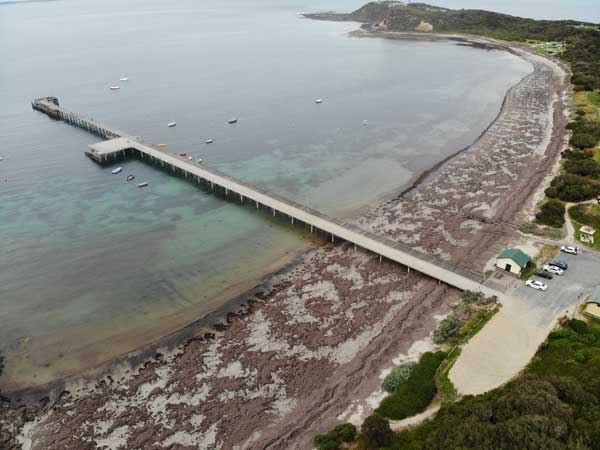 | 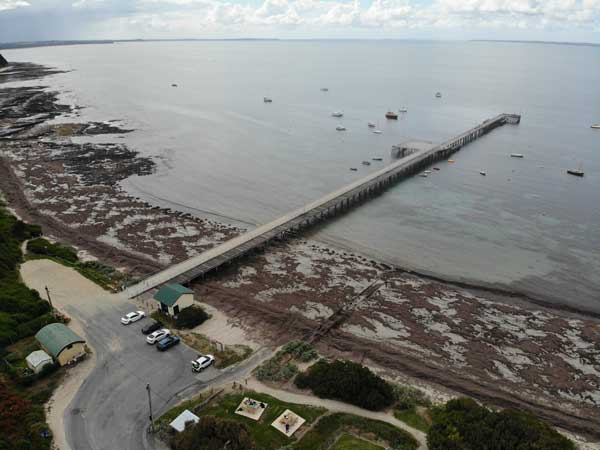 |
A drone shot of Flinders Pier looking south-east
Note the small parking area | A drone shot of Flinders Pier looking north-east
Enter the water on this side of the pier |
This site is subject to extremely large tidal changes. The tides can go from under 0.1 metres to over 3.2 metres. Of course, as it is a shallow site, the higher the tide the better, although there may be some tidal flow between high and low tides, but I don't think it can be that bad to affect a dive.
When I dived it was just after low tide (no other option really). It was also quite a large change that day, 0.05 to 3.2 metres, I did not notice any cross-current at all. As such, the tide was a long way out. We walked out (over a huge pile of dead seaweed) and across the very hard sand and out about 40 metres till it got deep enough to put on our fins. Then we swam out another 20 or so metres and descended.
The depth was very shallow, less than 2 metres. We probably should have added a bit more lead to make ourselves heavier, but we did not have too much trouble. We headed out towards the end of the pier along the right/southern side. The bottom is sand with lots of weed and dead weed. As we go we are looking for sea dragons of course, but also anglerfish.
 | 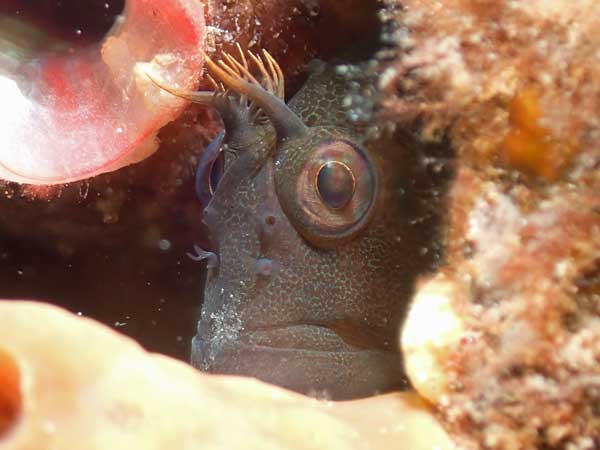 |
| A typical pylon under Flinders Pier | A Tasmanian blenny in one of the pylons |
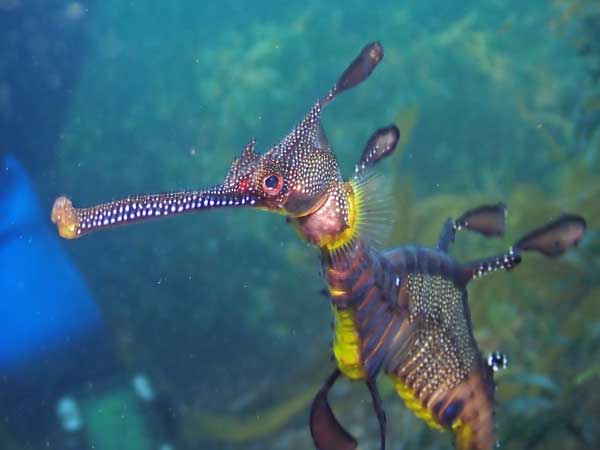 | 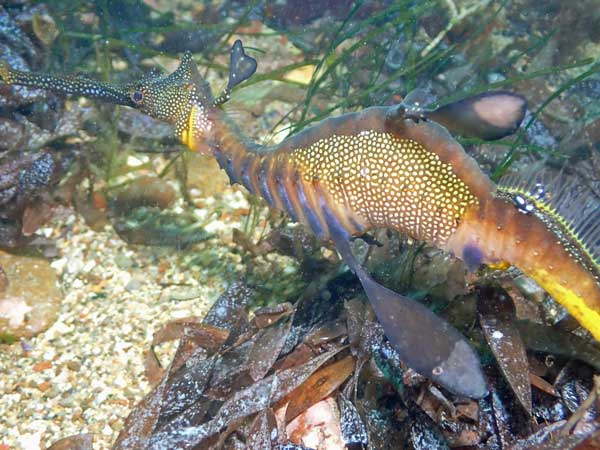 |
| A head shot of one of the sea dragons | One of the other sea dragons |
We soon see a sea dragon. This is darker and smaller than the ones we see in Sydney, but smaller than the ones I have seen in Tasmania. They seem to be coloured to match the darker weed. We also see a spotted stingaraee, a species not seen in NSW. There are quite a few small fish, some leatherjackets and a small flathead. The pylons of the pier have some growth on them. The first lot are in poor condition (you cannot walk on this section of the wooden pier) and we even see an octopus tentacle sticking out of a hole. We cannot see how the octopus go in the pylon.
Further along we see two more sea dragons. They are similar in colour and size to the first one. Apparently people have seen leafy sea dragons here, but this is rare. When we get to the end of the pier (depth was 3.1 metres) we went right around the end section (see the drone photos) and then started back along the northern side (still the right as we head back).
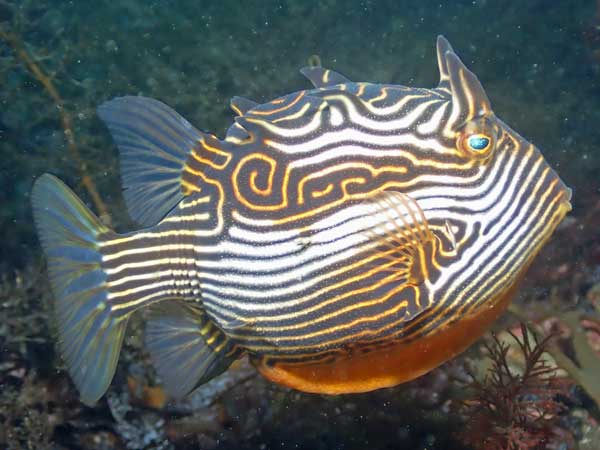 | 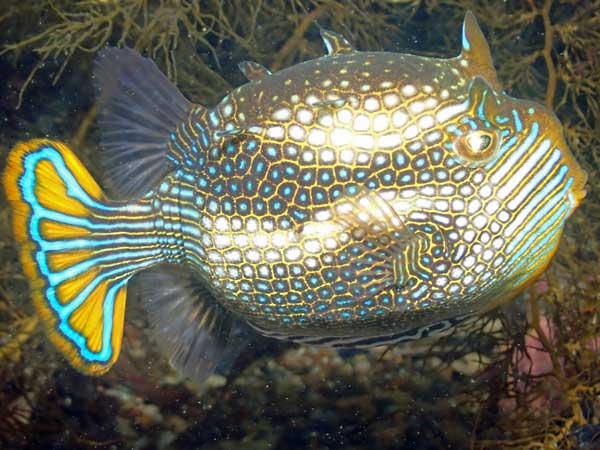 |
| A female Shaws cowfish | A male ornate cowfish |
 | 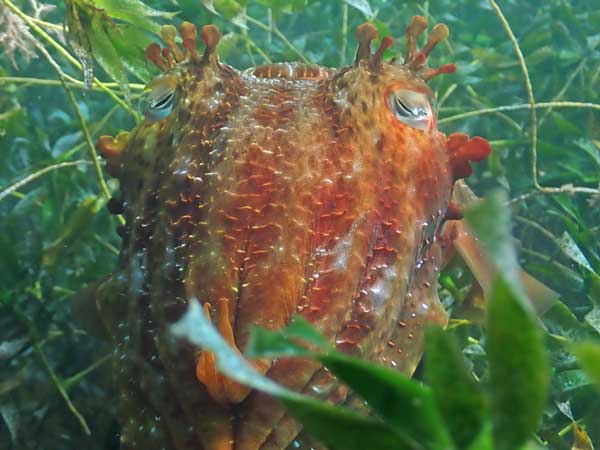 |
| A spotted stingaree | One of a couple of cuttlefish I saw |
We see a few large octopus, one large cuttlefish but no more sea dragons. At the halfway point where the newer concrete pier ends, there is a large platform so we follow the outside and also look over the middle bit. After this we continue on the northern side towards the beach, now we are under the concrete section. When it gets too shallow to keep going, we surface and end the dive. It is a simple walk back to the beach.
As mentioned this is a very shallow dive at low tide, but even at highest tide it would be only 6 metres at the most. The visibility on my dive here was only about 3 metres or so. The water temperature in April was 17C. A nice dive.
| 
 v6.00.307 © 2003-2005
v6.00.307 © 2003-2005